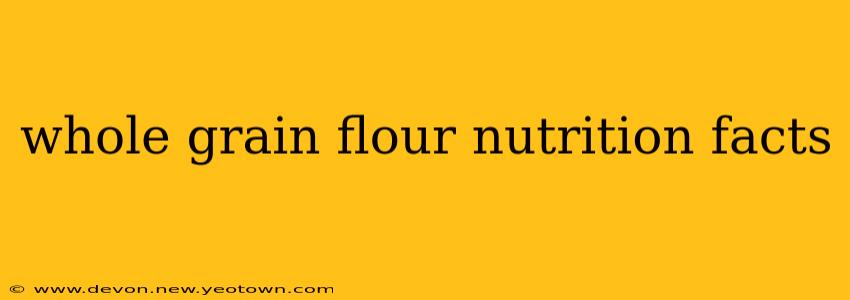Whole grain flour, unlike its refined counterpart, retains the entire kernel of the grain – the bran, germ, and endosperm. This seemingly small detail makes a world of difference in its nutritional profile, offering a wealth of benefits that refined flour simply can't match. Let's delve into the incredible nutritional powerhouse that is whole grain flour.
Imagine a humble kernel of wheat, barley, or rye, each brimming with potential. The bran, the outer layer, is packed with fiber, adding bulk to your diet and promoting healthy digestion. The germ, the nutrient-rich embryo, boasts vitamins, minerals, and healthy fats – the essential building blocks for a healthy body. And the endosperm, the starchy core, provides energy in the form of carbohydrates. Refined flour strips away the bran and germ, leaving only the endosperm – a significant loss of nutritional value. Choosing whole grain flour means you get the complete package, a nutritional symphony orchestrated by nature itself.
What are the nutritional benefits of whole grain flour?
Whole grain flour is a nutritional powerhouse, brimming with essential vitamins, minerals, and fiber. Let's explore the key benefits:
-
Fiber: This is arguably the star of the show. Whole grain flour boasts significantly more fiber than refined flour. Fiber aids in digestion, preventing constipation and promoting gut health. It also helps regulate blood sugar levels, contributing to weight management and reducing the risk of type 2 diabetes. The soluble fiber in whole grains helps lower cholesterol, protecting your heart health.
-
Vitamins and Minerals: The germ, retained in whole grain flour, is a treasure trove of essential vitamins and minerals. You'll find significant amounts of B vitamins, vital for energy production and nerve function. Minerals like magnesium, iron, and zinc are also present, contributing to various bodily processes. Magnesium supports muscle and nerve function, while iron is crucial for oxygen transport, and zinc plays a vital role in immune function.
-
Antioxidants: Whole grains are rich in antioxidants, which combat free radicals in the body, protecting cells from damage and reducing the risk of chronic diseases. These antioxidants contribute to overall health and well-being, helping protect against premature aging and various health problems.
What are the different types of whole grain flour?
There's a whole world of whole grain flours beyond just wheat! Each offers its own unique flavor and nutritional profile:
-
Whole Wheat Flour: The most common type, made from the entire kernel of wheat. Its nutty flavor adds depth to baked goods.
-
Whole Rye Flour: Known for its slightly sweet and tangy flavor, and higher fiber content compared to wheat. It lends a distinctive character to breads and other baked goods.
-
Whole Oats Flour: Made from ground oats, it is naturally gluten-free and provides a substantial amount of fiber and nutrients. It is often used in gluten-free baking and adds a slightly sweet flavor.
-
Whole Barley Flour: Similar to wheat flour in texture but with a slightly sweet and nutty flavor. It's a good source of fiber and adds a unique taste to breads and baked goods.
How does whole grain flour compare to refined flour?
The difference is stark. Refined flour, stripped of its bran and germ, is primarily carbohydrates with little fiber, vitamins, or minerals. Whole grain flour, on the other hand, offers a complete package of nutrients essential for optimal health. While refined flour might provide quick energy, whole grain flour offers sustained energy release, improved digestion, and a multitude of health benefits.
Is whole grain flour better for weight loss?
The high fiber content in whole grain flour promotes satiety, meaning you feel fuller for longer. This can aid in weight management by reducing overall calorie intake. The fiber also helps regulate blood sugar levels, preventing those energy crashes that often lead to unhealthy snacking. While not a magic bullet, incorporating whole grain flour into a balanced diet can certainly contribute to weight loss efforts.
What are some recipes using whole grain flour?
The versatility of whole grain flour is remarkable! It can be used in a wide array of recipes, from hearty breads and muffins to pancakes and even pizza crusts. Experiment and discover new favorites! Many traditional recipes can be easily adapted to incorporate whole grain flour, offering a boost in nutrition without sacrificing flavor.
What are the potential downsides of whole grain flour?
While whole grain flour offers numerous benefits, it’s important to be aware of potential downsides:
-
Higher Fiber Content: For some individuals, the higher fiber content might initially cause digestive discomfort like bloating or gas. Gradually increasing the intake of whole grain flour can help your body adjust.
-
Shorter Shelf Life: Whole grain flour tends to have a shorter shelf life than refined flour due to the presence of oils in the germ. Proper storage in an airtight container in a cool, dark place is essential to maintain freshness.
In conclusion, embracing whole grain flour is a simple yet powerful step towards a healthier lifestyle. Its rich nutritional profile contributes to better digestion, sustained energy levels, and reduced risk of chronic diseases. So, next time you're baking, choose whole grain flour and savor the taste of wholesome goodness.

